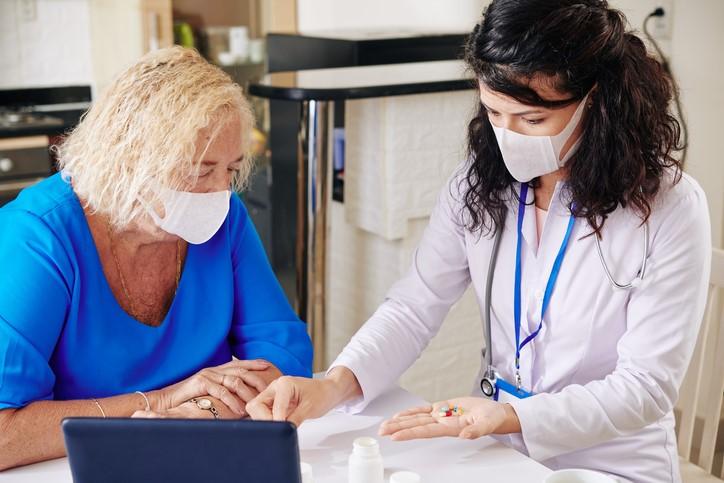A study of home healthcare workers (HCWs) in New York City published today in JAMA Internal Medicine found that the COVID-19 pandemic has exacerbated challenges they already faced as a critical yet vulnerable and marginalized workforce at high risk for coronavirus infection.
Led by researchers at Cornell University in a partnership with the 1199 Service Employees International Union, the study involved one-on-one semistructured interviews with 33 home HCWs employed by 24 different home care agencies from Mar 26 to Apr 30.
The investigators found that although home HCWs were on the frontlines of the pandemic and thus susceptible to coronavirus infection, they felt invisible and received an uneven flow of information, supplies, personal protective equipment (PPE), and COVID-19 training from their agencies. One HCW remarked, "I spent $20.00 to get a box of masks. . . . I walk all over just to buy a small can of Lysol for $7.00.”
Inadequate PPE, extra tasks, high rates of infection
Although many hospitals have managed to secure sufficient PPE since the beginning of the pandemic, home healthcare agencies are still undersupplied, the authors said, noting a Home Care Association of New York survey that found that 67% of home care and hospice agencies don't have enough PPE.
The HCWs said they had to rely on nonagency alternatives for peer support, information, and PPE and make difficult decisions in their professional and personal lives (eg, working and providing critical care vs risk of infection and lost wages and benefits).
Four of 33 participants (12%) reported that they had suspected or confirmed COVID-19—three times the rate of infection in the community at the time—and that they had stopped working after symptom onset.
Participants reported that most of their patients had more than one chronic condition, with the attendant high risk of infection, and that they had difficulty monitoring patients for COVID-19 symptoms because they were similar to their usual symptoms.
If home HCWs thought that their patient might have coronavirus, they said they called their agency, the patient's physician, or 911.
Many of the workers relied on public transportation to get to their patients, which increased their risk of infection, and some reported that more than one home HCW worked with some patients, increasing the risk of disease transmission. "There are 5 of us that work with her. . . . What happens if we all get sick?" asked one participant.
And in addition to their usual duties, the workers said they had to provide additional emotional support because their patients were worried about COVID-19, had to run extra errands to keep their patients safe at home, and had to do much more cleaning to ensure that surfaces were uncontaminated.
Mean participant age was 47.6 years, and all but 1 was a woman. Twenty-seven (82%) were minorities (21 (64%) black, 6 (18%) Hispanic), which also puts them at increased risk for COVID-19 infection. Twenty-two (67%) had completed at least some college. Participants had a mean of 10.9 years of experience in their field.
Long hours, low pay, structural racism
The authors noted that, while most HCWs have relatively brief encounters with patients, those who work in patient homes spend hours to days in close contact with patients, helping with activities such as bathing, dressing, feeding, and cleaning and often providing much-needed companionship and emotional support.
One of six home HCWs lives below the federal poverty line, and most work long hours, conditions which have led to high turnover rates and workforce shortages. And unless they are deemed "essential" workers, as they are in New York City, they cannot receive benefits such as paid sick leave or childcare during the pandemic.
Despite all the participants did to keep their patients safe, many HCWs said they worried about infecting them and felt invisible to both other HCWs and the community. Said one participant, "We're definitely a forgotten field. . . . You hear people clapping, thanking doctors and nurses, even the hospital cleaning staff. . . . I’m not doing this because I want praise; I love what I do. But it would be nice for people to show us gratitude."
The authors concluded that home HCWs need more support for their mental and physical well-being, including information and help avoiding public transportation, during the pandemic. "Already a vulnerable workforce, home health care workers face additional risks to their physical, mental, and financial well-being during the COVID-19 pandemic," they wrote. "Interventions and policies are urgently needed to protect this workforce and the vital role that they play."
In a commentary in the same issue, Theresa Allison, MD, PhD, and Krista Harrison, PhD, of the University of California at San Francisco, and Anna Oh, PhD, MPH, RN, of the San Francisco VA Health Care System, said that legislation is needed to ensure wage hikes, overtime pay, and paid sick, medical, and family leave to home HCWs.
Ultimately, they wrote, structural reforms are needed to address the structural racism at the heart of home HCWs inequities. "Just as COVID-19 has accelerated other aspects of medical and social progress, it is time to use the pandemic as an opportunity to engage in social justice for home care workers, recognizing the value of their work by investing in their health and financial security," they said.




















